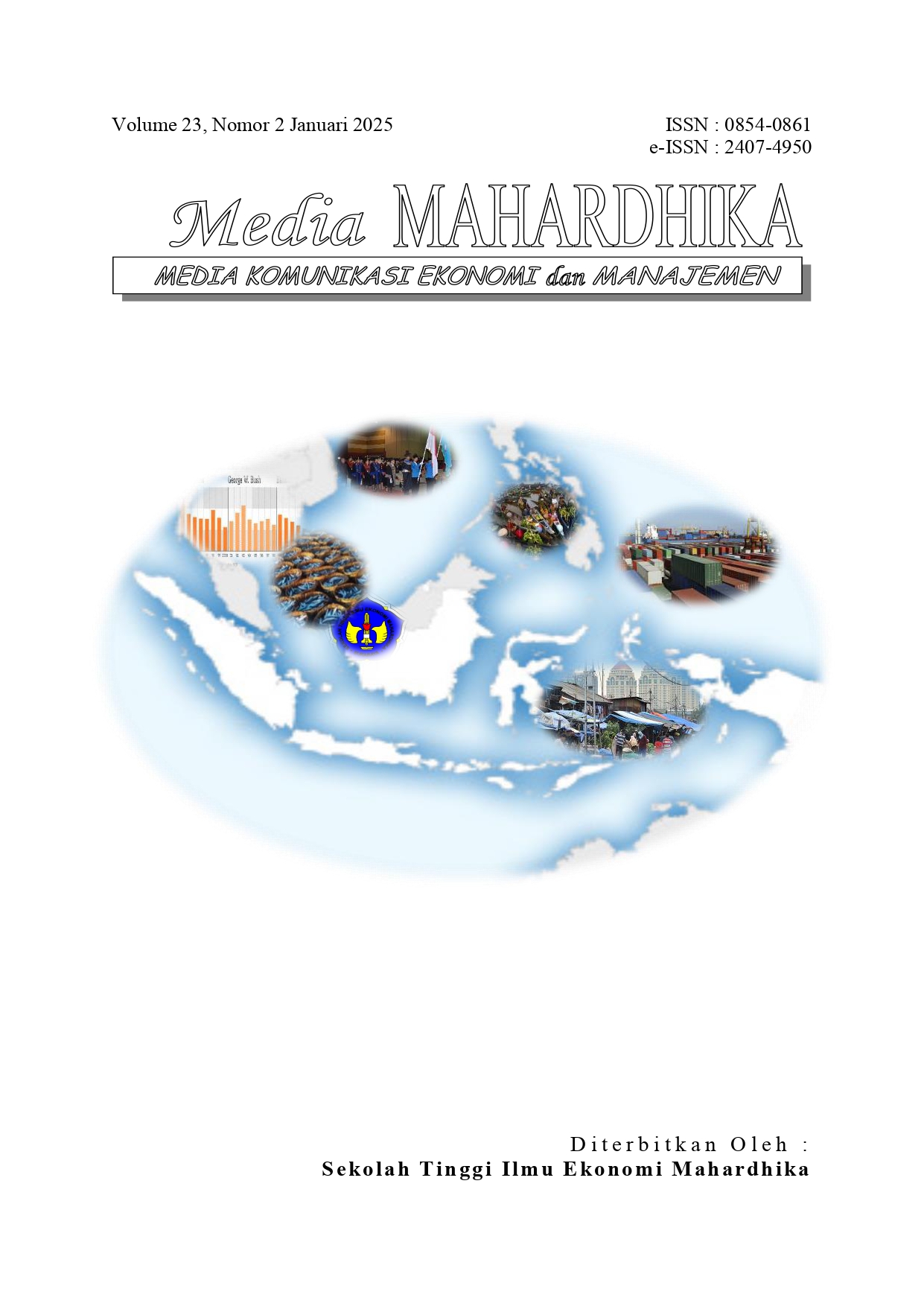ANALISIS PENERAPAN UNIFIED THEORY OF ACCEPTANCE AND USE OF TECHNOLOGY TERHADAP NIAT MENGGUNAKAN QRIS
(Studi Pada Generasi X Di Kabupaten Kendal)
DOI:
https://doi.org/10.29062/mahardika.v23i2.1249Keywords:
Unified Theory of Acceptance and Use Technology, Digital Payment, Customer BehaviorAbstract
Technological advances in the payment system have replaced the role of cash into a more efficient and economical form of non-cash payment. Bank Indonesia released a Quick Response (QR) Code standard for payments through server-based electronic money applications, electronic wallets, or mobile banking called the QR Code Indonesian Standard (QRIS). This study aims to determine the factors that influence behavioral intention to use QRIS by using Unified Theory of Acceptance and Use Technology (UTAUT) theory model. This study explores the Generation X in Kendal Regency, Central Java, Indonesia. The research method used quantitative method with 160 samples of Generation X in Kendal Regency, Central Java and used Smart PLS version 3.0. for analyze the data. The results of this study show Performance Expectancy, Effort Expectancy, and Social Influence has a positive and significant impact on Behavioral Intention the use of QRIS for Generation X in Kendal Regency, Central Java.
Downloads
References
APJII. (2024). Internet Indonesia. Survei Penetrasi Internet Indonesia, 1–73.
Aprianto, I. G. L. A. (2022). Tinjauan Literatur: Penerimaan Teknologi Model UTAUT. KONSTELASI: Konvergensi Teknologi Dan Sistem Informasi, 2(1), 138–144. https://doi.org/10.24002/konstelasi.v2i1.5377
Apriyani, R., & Pibriana, D. (2021). Penerapan Model UTAUT Untuk Menganalisis Penerimaan dan Penggunaan Sistem Informasi E-Office (Studi Kasus: PT ABCX) Application of the UTAUT Model to Analyze Acceptance and Use of E-Office Information Systems (Case Study: PT ABCX). Jurnal Teknik Informatika Dan Sistem Informasi, 8(3), 1557–1569. http://jurnal.mdp.ac.id
Arianisari, S. (2024). ANALISIS PERILAKU PENGGUNAAN QR CODE PAYMENT PADA. Jurnal Riset Akuntansi Dan Bisnis Indonesia STIE Widya Wiwaha, 4(2), 373–389.
Calvo-Porral, C., & Pesqueira-Sanchez, R. (2020). Generational differences in technology behaviour: comparing millennials and Generation X. Kybernetes, 49(11), 2755–2772. https://doi.org/10.1108/K-09-2019-0598
Damayanti, S. L., Yani, Y., Asnaini, A., & Afrianty, N. (2021). Minat Menggunakan E-Wallet pada Generasi Milenial dengan Pendekatan UTAUT (Unified Theory of Acceptance Use of Technology). Jurnal BAABU AL-ILMI: Ekonomi Dan Perbankan Syariah, 6(1), 63. https://doi.org/10.29300/ba.v6i1.3988
Dr. Duryadi, M. S. (2021). Metode Penelitian Ilmiah Metode Penelitian Empiris Model Path Analysis dan Analisis Menggunakan SmartPLS. In Penerbit Yayasan Prima Agus Teknik (Vol. 7, Issue 1).
Fadhilah, A. N., & Setiawardani, M. (2022). Analisis Penerapan Unified Theory of Acceptance and Use of Technology terhadap Niat Menggunakan Shopeepay. Prosiding The 13th Industrial Research Workshop and National Seminar, 1234–1241.
Ghosh, G. (2021). Adoption of Digital Payment System by Consumer: A review of Literature. International Journal of Creative Research Thoughts, 9(2), 2320–2882.
Hair, J. F., Hult, T., & Ringle, C. (2022). A Primer on Partial Least Squares Structural Equation Modeling (PLS-SEM) (L. Fargotstein, K. Offley, N. Tiwari, & G. Mahindra (eds.); 3rd ed., Vol. 19, Issue 5). SAGE PUBLICATIONS, Inc.
Hazbiyah, S., & Wuryanta, E. (2021). FENOMENA CASHLESS PADA PEMBENTUKAN GAYA HIDUP BARU GENERASI MILENIAL. IKON: Jurnal Komunikasi, 24(2), 185–199. https://doi.org/10.4324/9780429319297-14
Hill, R. (2017). Embracing digital: Key considerations for publishers, marketers and customers. Information Services and Use, 37(3), 349–354. https://doi.org/10.3233/ISU-170845
Krismawintari, N. P. D., & Komalasari, Y. (2019). Perilaku Pembelian Melalui Cashless Payment Pada Gerai Retail (Studi Pada Masyarakat Kabupaten Badung Bali. Sintesa Prosiding 2019, 5, 451–458.
Mahendra, K. C., & Rafik, A. (2022). Literasi Keuangan dan Perilaku Belanja Generasi X dan Y. Selekta Manajemen: Jurnal Mahasiswa …, 01(01), 1–12. https://journal.uii.ac.id/selma/article/download/23549/13552/66605
Mediyanto, B., & Mahendra, I. (2017). Penerapan Metode Utaut Untuk Memprediksi Behavioral Intentions User Dalam Menggunakan Aplikasi Zabbix. Jurnal Ilmu Pengetahuan Dan Teknologi Komputer, 3(Mediyanto), 10.
Mooduto, W. P. A., & Mariam, I. (2020). Penerimaan dan Penggunaan OVO Paylater dengan Menggunakan Model UTAUT. Jurnal Administrasi Profesional, 1(02), 8–15. https://doi.org/10.32722/jap.v1i02.3659
Mukminin, A., Rachman, R., Wahyudi, H., Bina Sarana Informatika, U., Nusa Mandiri, S., & Mardira Indonesia, S. (2019). Penerapan Model Utaut Untuk Perilaku Pengguna “Paylater” Di Dalam Traveloka. Jurnal Computech & Bisnis, 13(2), 81–90.
Pah, V. C., & Kornelius, K. (2023). Pengaruh Behavioral Intention Dan Penerapan Model UTAUT Terhadap User Acceptance Digital Payment In Quick Response Indonesian Standard (Qris). Journal of Economics & Business, 12(1), 1–23. https://www.jurnal.ubs-usg.ac.id/index.php/joeb/article/view/145
Prasetyo, D. Y. (2017). PENERAPAN METODE UTAUT dalam website KKN LPPM UNISI. Jurnal SISTEMASI, 6(2), 26–34.
Ramli, Y. (2020). Adopting Digital Payment based on the Features and Benefits provided by the Application. European Journal of Business and Management Research, 5(3), 1–6. https://doi.org/10.24018/ejbmr.2020.5.3.340
Thirupathi, M., Vinayagamoorthi, G., & Mathiraj, S. P. (2019). Effect of cashless payment methods: A case study perspective analysis. International Journal of Scientific and Technology Research, 8(8), 394–397.
Yusri, A. Z. dan D. (2020). Modul pelatihan penelitian kuantitatif dengan aplikasi SMARTPLS. Jurnal Ilmu Pendidikan, 7(2), 809–820.
Downloads
Published
Issue
Section
License
Copyright (c) 2025 Annisa Fitri Fauziah, Nanang Apriliyanto

This work is licensed under a Creative Commons Attribution-ShareAlike 4.0 International License.






